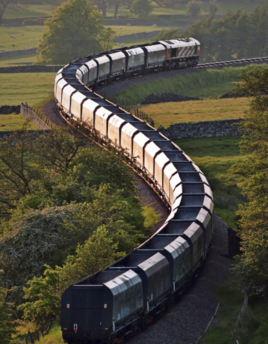Quick wins: the low-hanging fruit
“The starting point is to do things, rather than talk about them,” says Professor Simon Blainey at the University of Southampton’s Transportation Research Group.
“We have been talking about network-wide electrification for 20 years. Just do it. It will deliver decarbonisation effectively. Battery and hydrogen may be useful as back-up, but they aren’t as efficient as overhead electrification, or even third rail.”
RIA’s David Clarke says the starting point is to electrify the main diesel lines, beginning with the rest of the Midland Main Line and over the Pennines. East West Rail should be electrified from the start, he says.
“And Great Western - it would be easy to complete the job that was stopped partway through. The prep has all been done. All the work through Bath - the bridges are cleared and the power is in place.”
Clarke adds: “There is such a lot to be done around reducing our energy consumption. Not all stations have LED lighting. Stations should be exemplars of sustainability in terms of energy use and waste-water recycling.
“There needs to be a change in mentality. There is no value put on carbon saving in tenders. If there was, say, a 5% premium on doing a job the low-carbon way, a bidder wouldn’t put that in, because 5% could be enough to lose the bid. Network Rail now expects all designs to be run through a carbon tool to give it a value, but I am not sure it is reaping what it should.”
Rob Morris, Managing Director of Rail Infrastructure at Siemens Mobility, says the Government needs to mandate green technology in all purchasing processes.
“If you want change ‘now’, then ‘now’ actually means a purchasing process has to start. Somehow, we have to unlock the fuzziness around competition. Everything is cost-based, as opposed to value-based. The technology to change things is available now - we just need to leverage it.
“If you unlock the opportunity to bring in third-party investment, it will be quicker because there will be no up-front public capital expenditure at a time when the public economy is stretched and struggling. Third-party spending will bring forward the operational and carbon savings.
“There is loads to go at, but on current plans I can’t see the railway being decarbonised until 2060. Or beyond. It just won’t happen unless we bring that investment forward.
“We are doing it in pockets. Outcome-based specifications create the environment. In Scotland, in our signalling partnership, Siemens Mobility is working in harmony with Scotland’s Railway, with early contractor involvement. We are developing new ideas in partnership, looking at each route as a whole rail system and recommending the best technologies for each section, such as battery or hydrogen as interim or permanent solutions, depending on the feasibility of electrification.
“On the East Coast power supply upgrade, we are working with Network Rail to come up with the most energy-efficient solution. In-cab signalling makes the railway more reliable, but it also has less installed carbon because there is less infrastructure - no lights on sticks, less concrete, more cloud-based technology.
“These are system components. What we need is a mandate from Government, explicit about the way things are purchased for the whole system, at pace, if the targets are to be met.”
Blainey says: “We need to understand the embedded carbon in the infrastructure. For a lot of standard procedures in rail, there is no knowledge of how much carbon is produced. We need to understand where it is generated and where the problem areas can be found. From there, we can find the quick wins.”
Anderson agrees: “This is motherhood-and-apple-pie stuff. We need tools to assess carbon benefit against cost ratios, and work fast to produce more effective carbon-accounting tools. I suspect the way we account for carbon isn’t keeping up.
“Happily, these often go together - less material has a strong correlation with reduced cost and quicker construction. And this can be continuous improvement - start building now, but get better as you go.
“Network Rail is planning research into wind loading on overhead line equipment, better pantograph performance, and the actual behaviour of structures. The more you understand, the more reliable and economical the designs will be.
“It may not get the headlines of hydrogen and batteries, but composite masts matter. We have to start eating into our carbon emissions now. The sooner we get our act together on the infrastructure programme, the sooner the fleet can be decarbonised.”
Blainey says: “Rail is still fundamentally a more carbon-efficient mode than others. We just need to make sure that building is about bringing people from other modes, and not just making things better for people who already use rail.
“So, don’t build for yesterday’s market. This is where some capacity enhancement schemes in the South East may no longer be needed. They may not be the most sensible way to spend carbon.”














